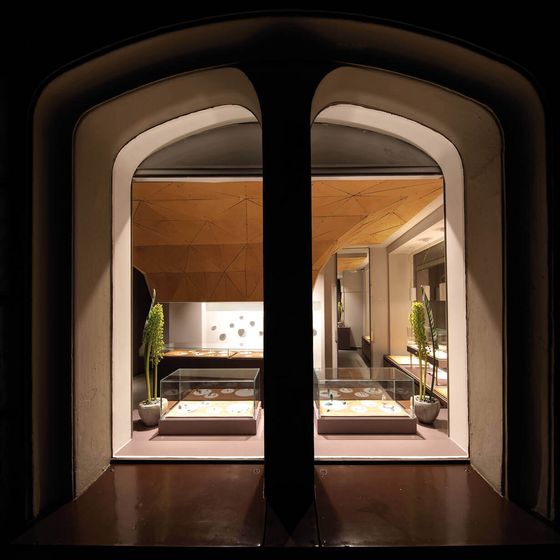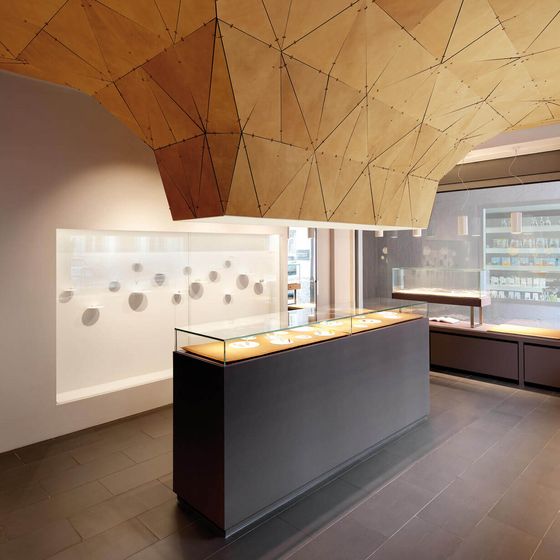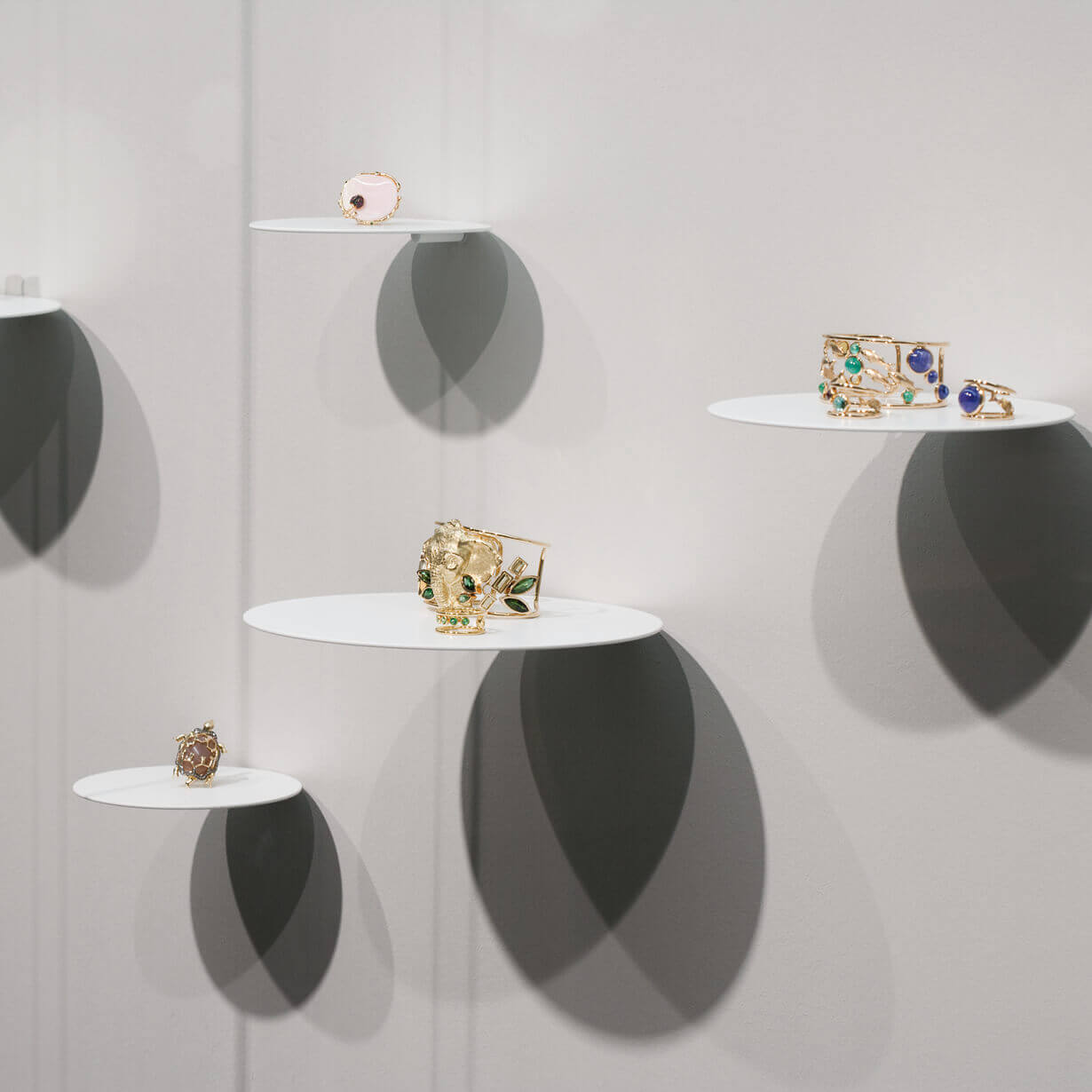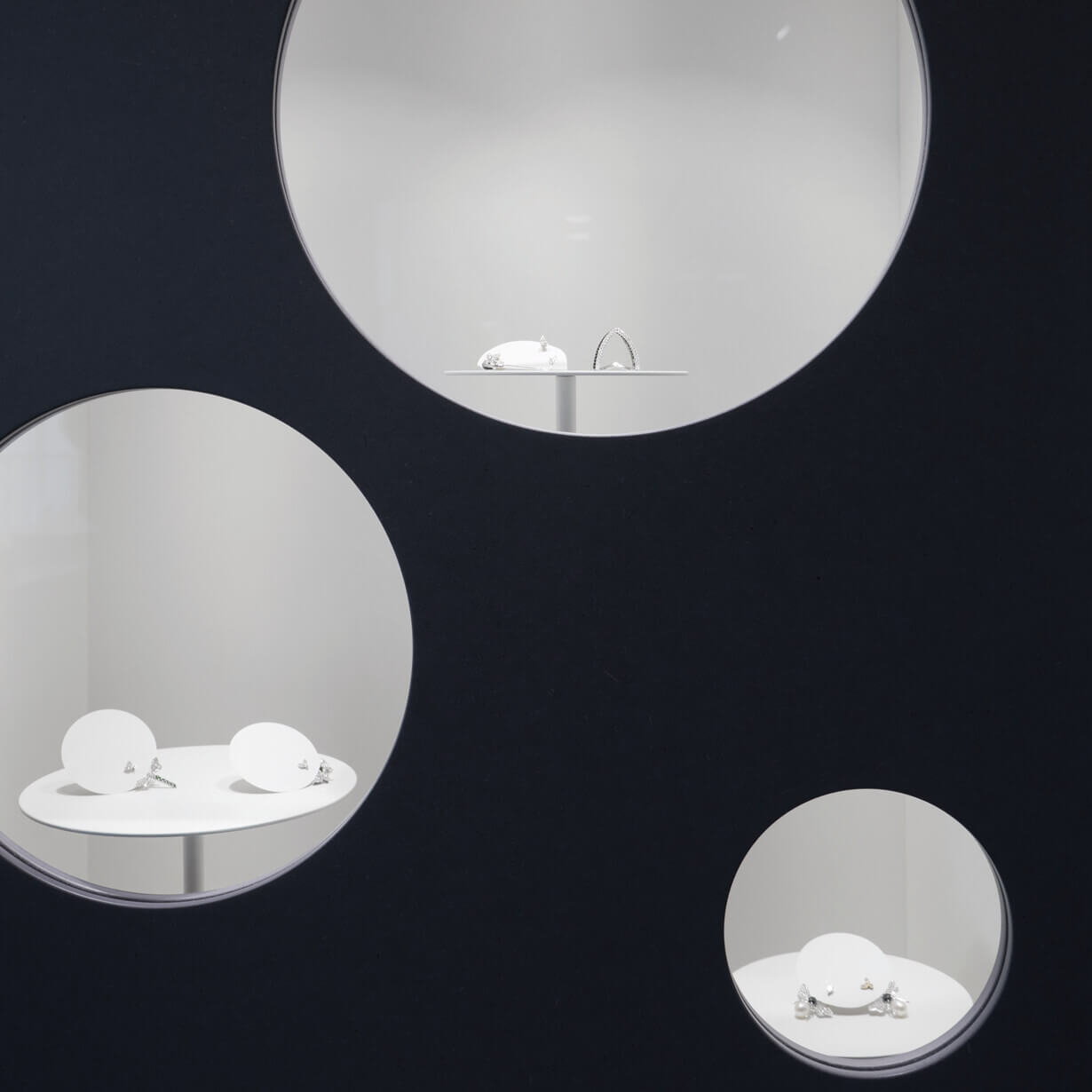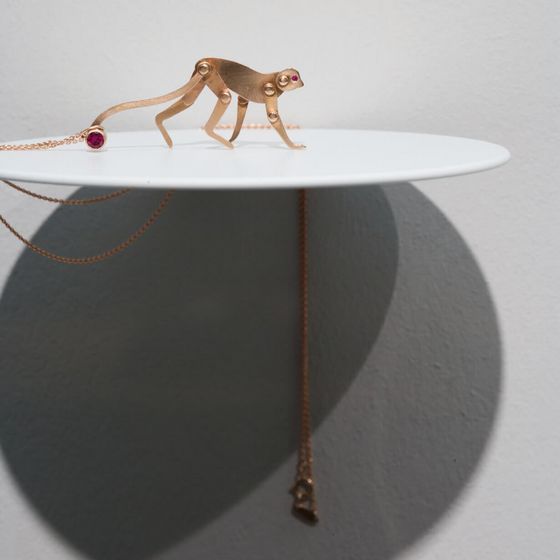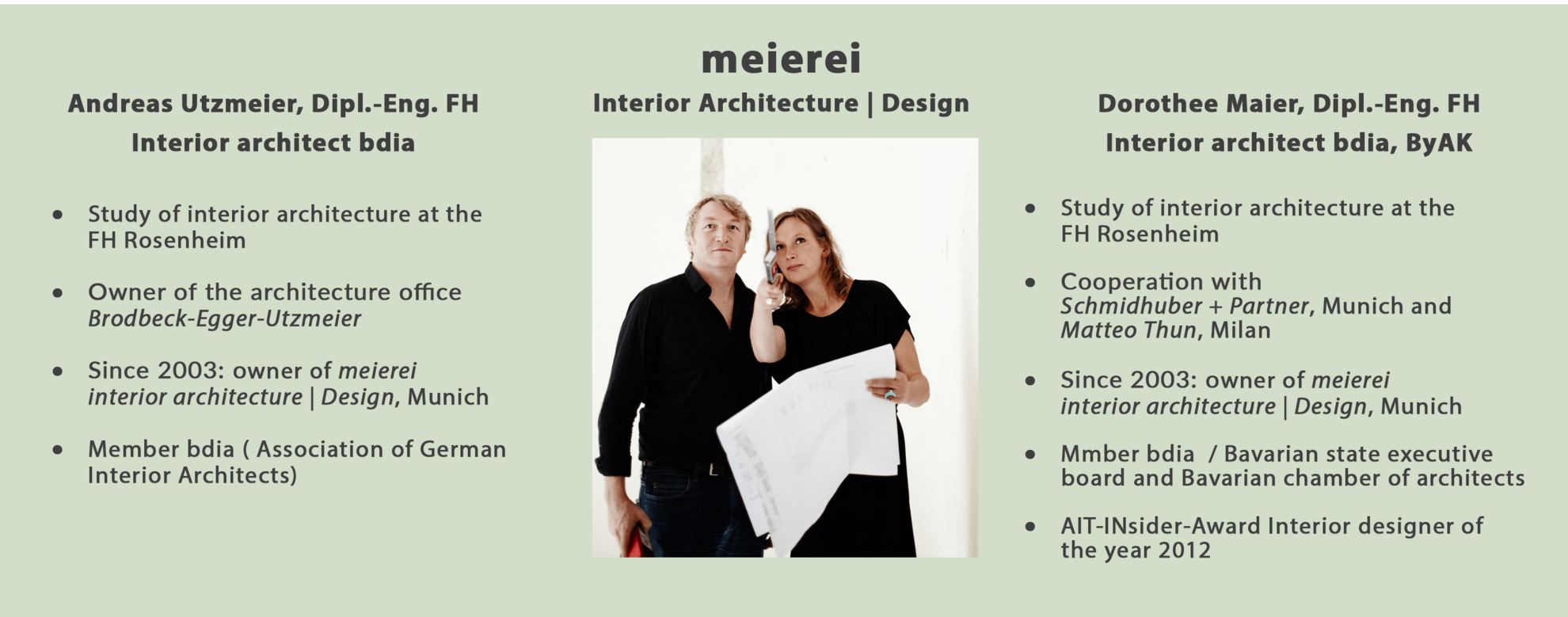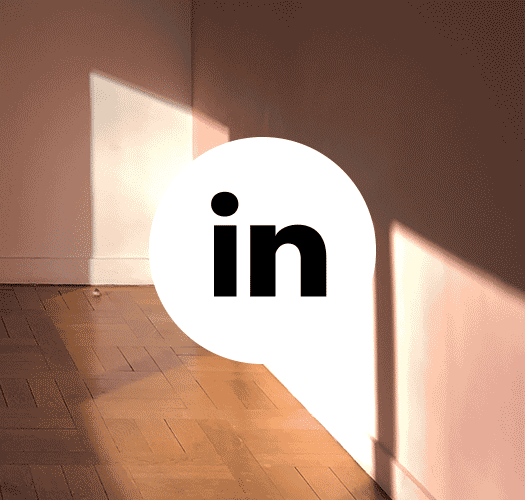Interior architecture as a full-body experience – Dramaturgical elements of an interior
The meierei Interior Architecture and Design in Munich designs creative and emotional spaces based on clear conceptual ideas. Since its founding in 2003, the two owners, Dorothee Maier and Andreas Utzmeier, want to make the character of companies and personalities visible and tangible.
The philosophy of meierei: "You feel our spaces, live them, sense the conceptual thought by which they are carried. Our passion is held by spaces which communicate something and stir positive emotions. Rooms that feel good also come across right."
Since the architecture office exists, it has been awarded several times with the German Design Award and for the fourth time in a row they received an entry of their projects in the "Architektouren" (Bavarian catalogue of must-see architecture projects). One of the most successful projects in the last few years was the addore store in Munich, with three awards: the German Design Award, the "AIT Award Best in Interior and Architecture 2016 Special Mention" and the "Inhorgenta Award 2017" for their innovative shop design.
We asked the owners how they proceeded in terms of conception and design in this project and how they created a "full-body experience". We also wanted to know which steps are necessary for a successful colour design.
An enactment that gets on the skin
Behind the beautiful Jugenstil façade of a house in the Prannerstrasse, in the middle of the pedestrian area of Munich, hid an insignificant jeweller´s shop, which the addore owners acquired. However, the businessmen could not identify themselves with the pre-existent interior and commissioned the meierei to design a puristic-modern shop, which makes the curiosity and reflects the positioning of addore – unique jewellery from selected designers from all over the world. It is intended to create a jeweller´s shop, which underlines the individuality of the jewellery and which seems rather like a gallery.
The existing shop windows, which consisted of showcases and did not make the store visible, gave the two interior architects the idea of converting the business into a treasure chest. Their idea was that customers are drawn through the shop window into the store and, when they enter, they experience an aha moment. One should be free to move around the jewels, which are laid out in the middle as if they were put on an altar.
Through three dramaturgical elements, the meierei creates an experience space in the addore store:
During the planning of the colour and material concept, the meierei first asked oneself elementary questions: Where and how much will we use of what colour? How are the surfaces facing the light? Which materials can be combined in the interior and which are already available?
It was particularly important to the two interior designers to visualize the topic of jewellery. Whereas jewellery is always worn directly on the skin, they had the idea to use natural tanned leather. The pieces form itself into 236 finite triangle elements to a kind of vault sculpture, the "drop", which grows down like a stalactite in the middle of the room. The individual elements are joined by leather straps.
Due to the strictly geometric leather elements, the drop is very modern and contrasts with the surface of the skin, which also contains imperfections due to the natural grain. These are intended and act as the antipode to the "cleanness" that predominates in the room. The brass-coloured tone of the leather characterizes the atmosphere in the room and makes it warm. "The atmosphere of the room would suffer from a lack of warmth if we had used bright neon tubes and the association to softness, which jewellery worn on naked skin arouses, would be lost," explains Mrs Maier.
Mr Utzmeier explained that the vaults sculpture had to be staged and that the highlight, the altar, had to be spotted immediately. The counter is a single glass cabinet in which jewellery is laid on leather cushions. Not only is the idea of leather and skin being continued, the interior designers also find that the filigree jewellery is best presented in subtle colours.
"Then we looked at the geometry of the room, i.e. ceiling, wall and floor. Despite our general freedom of design for addore, we were bound to the fact that the dark grey flooring already existed. It was clear to us that due to the brass-coloured drop and the dark grey flooring no further strong colour would fit and so the subtle colour concept for the walls has been developed. A bright grey and a tinted white tone, so that the transition between the colours in the room is not too hard. This subtle colour design created an optimal background for the drop to be staged. Because of the floor, wall and drop colours, the interior, i.e. the counter and panels, had to be grey - the colour was set by the material."
A further enactment is the round cut-outs in the wall, the "bubbles", which are brightly illuminated and behind which the jewels conceal themselves. The meierei would like to "focus" the view on the pieces, i.e. no large showcases with hundreds of jewels in it, but the focus on unicas. The bubbles are another attribute that plays with the austerity of the space. Taking up the round form, there are plates on a further wall of the room, suspended for precious items; through refined lighting, the plates also cast a round shadow on the wall. This resulted in a reduction to a few forms. The repetition and concatenation of elements of different sizes gives a consistent environment to the room.
The "meierei´s steps" to a successful colour design
Define the initial position and the target position
What is my starting position and where do I want to go?
What materials are already available?
→ Consider that certain equipment may be provided.
• Differentiate the geometry of the room
Which components of the room – floor, wall, ceiling – would I like to emphasize?
• Determine the energy level of the colour
What do I want to convey in the room?
Should be calmed or activated?
Let your emotions run freely regarding the number of colours and the colour
selection.Combine materials and colours that support each other.
• Specify the colour space
How many and which surfaces should be coloured?
→ In this case, it may be advantageous to think in partial areas, i.e. to use certain
shades only for parts of wall, ceiling or floor.
• Include the light
How are the selected surfaces placed towards light?
Is it natural or artificial light?
→ Remember that colour shades can vary greatly depending on light incidence and
lighting!
• Do a colour sampling
Paint the selected colour(s) partially on the selected walls.
Do the colours and colour combinations in the room affect my goals?
→ Leave the sample for about three days before painting the entire surface.
• Colour as an amusement factor
Be brave and design!
Even if you do not like the wall colour in a year, you have lost little, just re-design!
• Excursion: Accentuation
Use matching or interlacing colours which are also in harmony with your interior
setting. Do not set the accentuations space-dominant!
Do not use too contrasting colours, these are loud and the space loses the balance
(unless you intend this).
"It isn’t expensive to create a good environment, it’s expensive to live in the wrong one."
– Dorothee Maier –
Colour as an activating factor
Through colour in architecture, the viewer is cognitively influenced; colour is an activating factor, which can be positive or negative, but always causes a reaction. The observer always experiences a subconscious full-body experience. Mrs Maier explains this: "Architecture has the task to make surfaces work in large dimensions. In this exercise, it is difficult to find the right colour. Most colour systems cannot display the dimension, because when a surface is sampled, this is often done within the limits of a DIN A4. The customer then has the problem of imagining this sample on a large wall. With Le Corbusier's colours, it is known that this test has been carried out, the colours have been tested - in his own rooms and buildings. Therefore, these colours are capable of filling large areas without being too invasive. And this makes the difference between the Architectural Polychromy and other colours."
Whether in harmony or in contrast, materials, interior elements and furniture should have an aligned colour design. The extensive portfolio of products in certified Les Couleurs® Le Corbusier colours enables the harmonious colouring in commercial, public and private areas.


